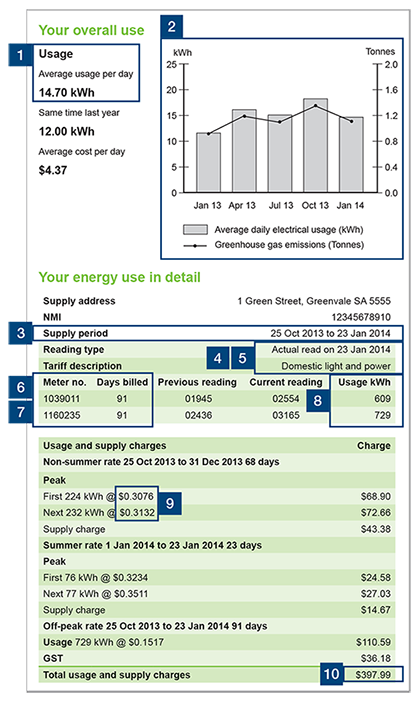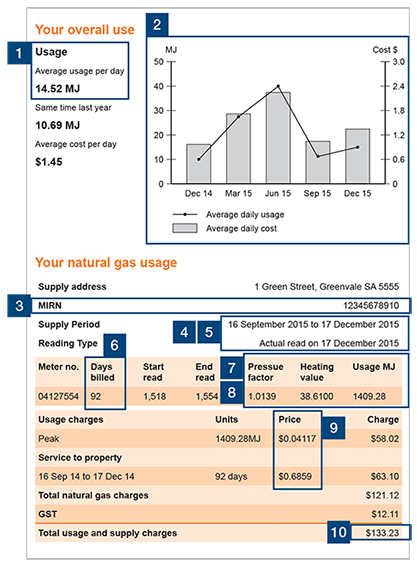On this page
The information on your energy bills can help you:
- understand how you are charged and if there is an error
- keep track of how much energy you are using
- compare your use with other homes in your area.
Reading electricity bills
This bill is an example and your bill might look different. For example, if you have solar panels, the kilowatt-hours (kWh) exported will be shown.

- Average usage per day - measured in kWh over the billing period
- Usage graph - pattern of electricity used compared to the previous bill
- NMI (national meter identifier) - unique serial number for the address
- Billing period - date range for the bill
- Read type - actual or estimate of how much electricity has been used. This is sometimes referred to as a or e on the bill.
- Meter readings - this property has 2 meters, so 2 meter numbers - off peak and peak. Smart meters can record both readings on one meter.
- Billing days - number of days this bill covers. Around 91 days is 'quarterly'.
- Consumption - total number of kWh used per meter
- Tariff - prices per kWh to be paid for different periods
- Total due - amount owed for supply and usage including unpaid amounts.
Many energy retailers have online examples of their energy bills you can refer to.
Reading gas bills
This bill is an example and your bill might look different.

- Average usage per day - measured in megajoules (MJ) over the last billing period
- Usage graph - the pattern of gas used compared with previous bills
- MIRN – meter installation reference number - unique meter serial number for the address.
- Billing period - date range for the bill
- Read type - actual or estimate of how much gas has been used. This is sometimes referred to as a or e on the bill.
- Billing days - number of days this bill covers. Around 91 days is 'quarterly'.
- Pressure and heating value - used to cross check the meter usage and the MJ usage on your bill - [meter reading] x [pressure factor] x [heating value] = MJ
- Consumption - total number of gas units used in MJ
- Tariff - Prices paid per MJ. Usage charges will change depending on how much gas is used. Service charge is fixed.
- Total due - amount owed for supply and usage including unpaid amounts.
High energy bills
Compare your current bills with previous ones - preferably over the last year. This can help you understand why your bill has changed.
Your bill could be higher than normal because:
- you're using more energy - for example, different seasons or you're at home more
- the tariffs you pay have increased
- discounts you receive have changed
- new fees and charges are included - for example, late payment fees
- unpaid amounts from previous bills have been added.
Getting help with energy bills
Contact your retailer if you're having trouble paying your energy bills. By law, they must you help you find a solution. This could include:
- offering you a payment plan
- joining their hardship program
- directing you to other services that can help.
If you are having financial difficulties, a financial counsellor can help you get back on track. Their services are free.
Billing errors
Errors on your bill are uncommon but could happen due to a technical glitch. This type of error could include:
- the wrong tariff amount was used to work out the charge
- peak electricity prices were applied to an eligible off-peak appliance
- credit for electricity fed back into the grid was not included.
The meter reader could also record the wrong numbers if your meter was read manually.
Estimated bills
An estimate might not be 100% accurate but can be used if the retailer hasn't been able gain access your meter. They will base the amount on your past use or the average use in your area. Actual readings will be used once the meter can be read and your bill will be adjusted.
You'll see e or estimate next to the usage amount if your bill is calculated using an estimate.
Overcharging
The retailer must repay you when they've made the error.
If the amount is:
- less than $50, you must be credited the amount on your next bill
- more than $50, you can request an different method for repayment, such as a cheque.
Undercharging
You could receive a catch-up bill if you've been undercharged. For example, the estimated use was less than how much you actually consumed.
The catch-up bill must include:
- the billing period
- the tariffs and charges that should have been used
- the amount you consumed at each tariff.
You must pay the full amount owed if you haven't provided appropriate access to the meter. But you can pay it over time or in instalments.
- If it occurred for less than 12 months, you must be offered the same length of time to pay
- If it has occurred for 12 months or more, you are entitled to 12 months to pay.
If the retailer was at fault, they can only recover the amount undercharged in the nine months before they notified you.
Related information
On this site
- Help paying energy bills
- Understanding meters
- Calculate your appliance running costs
- home energy audit
- Energy Advisory Service
Other websites
Energy and water bills - Energy and Water Ombudsman of SA

